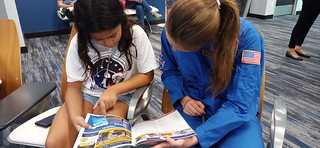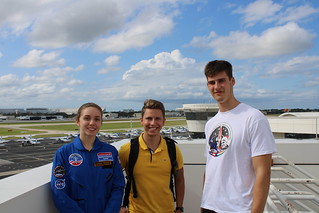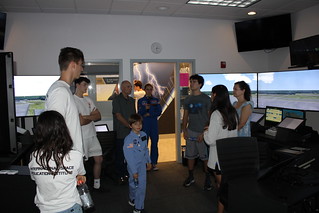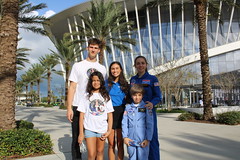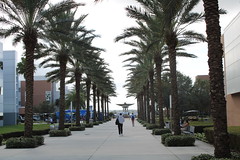| Excursions - NASA Tour |
From “Return to Flight” to “Return to the Moon”
change after 20 years of SpaceEducation
by Ralf Heckel
Fotos Cosmas Tagebuch Rovernauts Startberichte Raumfahrt Concret Werner-Heisenberg-Gymnasium

 Last night at 1:47 am, Artemis 1, the brightest rocket of all time, was launched towards the moon. I was there with a handful of students from 3 continents. They are all currently struggling for words and trying to write down their experiences. It's not easy at all. It was her first experience of launching a giant rocket. The whole year 2022 on standby, two transatlantic travels, a cancelled attempt by hurricane Ian, presentations at the 37th German Space Day, sleepless nights after a long flight and finishing homework, jet lag and excitement put everyone in a trance that feels like being on a submarine.
Last night at 1:47 am, Artemis 1, the brightest rocket of all time, was launched towards the moon. I was there with a handful of students from 3 continents. They are all currently struggling for words and trying to write down their experiences. It's not easy at all. It was her first experience of launching a giant rocket. The whole year 2022 on standby, two transatlantic travels, a cancelled attempt by hurricane Ian, presentations at the 37th German Space Day, sleepless nights after a long flight and finishing homework, jet lag and excitement put everyone in a trance that feels like being on a submarine.
But it all goes back 20 years. Exactly 20 years ago in the autumn, Professor Dr. von Puttkamer said: "I'm in Leipzig right now and if you want, we can meet up." Freshly in love with Yvonne, we came to the Hotel Fürstenhof and listened to what the professor had to say. “We will soon be expanding the ISS and for that we need young people, because one day we want to go back to the moon. If you do well and stick to that goal, I promise you'll be there with a new generation of space explorers.” At the time, that sounded too fantastic to be true. Nevertheless, it should take 20 years until this promise should come true in return for solid youth work around the world.
Step by step we implemented the professor's ideas until he opened doors at NASA in return. The first launch window opened three years later with an invitation to the shuttle launch at Cape Canaveral. "Return to Flight" was the name of the flight of the Discovery, which was the first space shuttle to resume flight operations after the Columbia disaster. Pilot Eileen Collins heralded the space age of women. Since then, the ISS space station has been expanded and 10 years ago the last of the proud swans flew. We saw 3 launches and one landing, mostly with students. We provided the first international team at the NASA Rover Challenge, won prizes and inspired thousands of students with complex trips around the world, from which hundreds of teams emerged. Everything always with the words of the professor: "You have to be trail blazers and take responsibility for what follows!" That's how it happened until the 50th anniversary of Apollo 11, with the 3rd world champion title. Our strongest participants are the girls. They sit in the front of the pilot's seat, not only in the Roverchallenge.
But the female astronauts moved on board the ISS, the first woman on the moon is being discussed and “Helga”, an astronaut dummy from Germany, is now sitting in the Orion capsule. Astronaut Pamela Melroy , with whom we shared the same hotel in 2005, is now NASA's deputy administrator. That's why today more girls than boys are with me at Banana Creek, watching the rocket launch and listening to the instructions of the first flight director in history, Ms. Charlie Blackwell-Thompson.
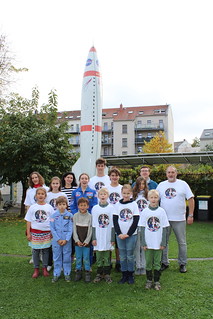
 In the last 20 years and especially between these two starts, Yvonne and I have not only built a campus that is created exactly for this Artemis generation (young people in contrast to the Apollo generation, which is now of retirement age), but also have our own 3 children brought another 300 international students on this path. 2 of them are with us today. There are 2 young women, both engineers. One, Valeria (24), is now an engineer at Tesla and works on the Cybertruck. The other, Sakurako (27), is now a pilot and engineer. She is aiming for an astronaut career with her home agency JAXA. Others have become aerospace engineers, entrepreneurs, managers, teachers or good craftsmen. Jasleen from India now works at Boeing in Houston. Firine, the pilot of our NASA Rover Challenge winning team of 2019 in the 50th year of the Apollo 11, has been studying aerospace engineering at TU Delft since this year.
In the last 20 years and especially between these two starts, Yvonne and I have not only built a campus that is created exactly for this Artemis generation (young people in contrast to the Apollo generation, which is now of retirement age), but also have our own 3 children brought another 300 international students on this path. 2 of them are with us today. There are 2 young women, both engineers. One, Valeria (24), is now an engineer at Tesla and works on the Cybertruck. The other, Sakurako (27), is now a pilot and engineer. She is aiming for an astronaut career with her home agency JAXA. Others have become aerospace engineers, entrepreneurs, managers, teachers or good craftsmen. Jasleen from India now works at Boeing in Houston. Firine, the pilot of our NASA Rover Challenge winning team of 2019 in the 50th year of the Apollo 11, has been studying aerospace engineering at TU Delft since this year.
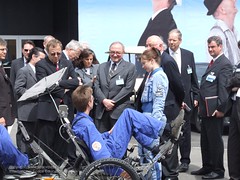
 Now that the pandemic has passed, we are starting with a whole new generation. That's why Cosma (15) and Arthur (17) are there as representatives of the high schools who can consciously pass on their experiences. Both did brilliantly, last week on the 37th Space Day, before NASA Associated Administrator of the Artemis program, James Free. We are now planning several world tours with them through numerous schools through 2026 as part of our own ambassador program similar to Work & Travel for SpaceExploration. There are partners in 30 countries on our list to work through. The smallest representatives are Jesco (8) and Valencia (11). They pass on their experiences in a playful way in primary and secondary schools.
Now that the pandemic has passed, we are starting with a whole new generation. That's why Cosma (15) and Arthur (17) are there as representatives of the high schools who can consciously pass on their experiences. Both did brilliantly, last week on the 37th Space Day, before NASA Associated Administrator of the Artemis program, James Free. We are now planning several world tours with them through numerous schools through 2026 as part of our own ambassador program similar to Work & Travel for SpaceExploration. There are partners in 30 countries on our list to work through. The smallest representatives are Jesco (8) and Valencia (11). They pass on their experiences in a playful way in primary and secondary schools.
These are all results that you don't have to hide from, no matter how rocky this path was and no matter how many setbacks there were. They are the result of solid work that must not be messed with. And as with all successful endeavors, ours also have their envious people. But more on that later. I see this as a distinguishing feature and award from people who capitulate to the need to "take the difficult path". Our former host from 2005, then-astronaut and administrator of US manned space travel, Bill Ready, is still our advisor behind the scenes today.
But now our small group of four is sitting in the Beachside Hotel in Cocoa Beach and writing down the experiences of yesterday. I'm trying it too.
Embry-Riddle Aeronautical University photos Cosmas blog Rovernauts Launchreports Raumfahrt Concret Werner-Heisenberg-School
Just in time for breakfast, we arrived at the room. A few minutes later, the hotel manager greeted us with her daughter. Valencia is 11 years old and also excited about space travel. That's why we agreed yesterday at check-in that we could take her with us today. As a thank you, her mother gave us a bigger room, because until now we lived in a quite small room. That is very nice of her.
She was running a little late due to a meeting and the crowded parking lots, but she finally came through the door. Now we were ready to go. Our guides were students Caroline and Madison. Both are studying for Homeland Security here. Caroline specifically in terrorism and children. Amazed, we left the building and walked across campus to the College of Arts and Science, which is particularly eye-catching due to the round observatory on the roof. This building has the largest telescope in the southeastern U.S. with 1m diameter mirrors. Astronomy, applied mathematics, physics, and social studies are among the subjects taught there. While we unfortunately did not enter this building, it was apparent that many students attend these classes, as the skateboard racks in front of the entrance were fully occupied. Short explanation: Since the campus is flat and large, most students move around with the help of (electric) longboards or (e-)scooters. To secure these in front of the entrance, there are also skateboard racks instead of bike racks. The campus area was well filled, as was the Union Center, which became our next stop as a break had just begun. This building is located in the middle of campus and it looks like a futuristic spaceship on the outside as well as the inside. After the main entrance, you find yourself in a dining hall. In the middle of the hall you can look up to the glass roof. If you go up the stairs, you will find a study area with open but also private spaces for the students. On the third floor is a large library equipped with soundproof glass. This is already where our tour ended. We said goodbye to Madison and Caroline and sat down in the dining hall. After lunch, we walked with Sakurako to the Aviation Maintenance Building, which is located next to the university's airfield. This belongs to the Daytona Beach International Airport, which we consider quite impressive. On the roof terrace, from which you can overlook the whole airfield with the regularly starting small Cessnas, but also large aircraft. Not far away, behind the airfield, we saw the Daytona International Speedway. There the worldwide known Nascar races are held. Suddenly, in a friendly voice in a familiar language, a "Hello you guys, you're from Germany too!" came up. It was a young exchange student from Stuttgart named Laurin. He is studying here, or rather also in Germany, to become a pilot. He has been here since August this year and seems to have had a lot of good experiences. We walked a little bit with him until it was time for our 2 p.m. Aviation Tour. This also started at the Welcome Center, from where we took a short detour to the Student Union and finally entered the Aviation Maintenance Building. There we visited both floors of the building. The first floor was mainly occupied by teaching and material rooms. In addition to weather stations, there are also technical seminars for international students. We especially noticed the altitude trainer (hypoxia training), which every prospective pilot has to pass at least 4-5 times. On the second floor there were primarily seminars and simulators that dealt with aeronautical science. We walked past many rooms where lectures were being given and students were studying. We then stopped in a room full of screens where prospective air traffic controllers were training. Jamie introduced a few of them and explained that all the procedures shown on the screens are live and real. The students use them to practice their skills. On the third and last floor, everything revolved around the weather. Right at the beginning there was a weather studio which was equipped with a green screen. This is where the university's own weather forecasts are recorded and shared internally. Many well-known weather presenters have already graduated from this university, as Jamie explained. As the walk continued, students were trained in weather forecasting, map reading, and reporting. In the process, we learned a thing or two as well. 14:40 we moved to Flight Operations across the hall. From here, students sign in for their flight lessons, are briefed, receive feedback, and enter the airfield. Also located here is the university's communications tower, which of course is also run by students.
With her arrival and an evening visit to the beach we let the day end. #rovernauts Embry-Riddle Aeronautical University
we have opened the gate of the NASA Moonbuggy Race for international teams in 2007 together with Prof. Dr. Jesco von Puttkamer. At that time, the International Space Station ISS was still very young. Puttkamer was its director. Since then, it has shown that international cooperation is very important. NASA and NASA Headquarters recognized this, and therefore NASA competitions were opened to international teams since 2008 under the condition of cost neutrality. We are proud to have facilitated this development, proud that more than 100 teams have walked this path with us to date. Proud to have found a basis of cooperation and friendly competition with you and also US teams. Because the future only works together. Since then, the NASA Roverchallenge has been a guarantor for honesty, transparency and fairness for 10 years. We were the point of contact and trail blazer for every new international team and enriched the race with 2 new awards (International Team, Telemetry). NASA awarded us for this in 2017. Thank you In this decade we are going to the moon again and it is our generation that will realize it. That is why international cooperation and collaboration has become even more important, also to defend our democratic freedoms against climate change, right-wing populism and war. Unfortunately, however, since 2017, HERC's new leadership has been unilaterally limiting precisely this cooperation, penalizing international teams and cooperation with U.S. teams. Also, the best international teams are rejected without transparent reasons without the possibility of a proper appeal with justification. This is what happened to our team since 2021. In the last decade we have achieved 3 first places, 4 other podium finishes and all other awards. We have and strive after the NASA Core Values to also be Trailblazer for teams from 30 other countries. We are happy to be on the road with you. This refusal to compete is arbitrary and damages honest competition. Many of you can not explain why this is so. We have taken the trouble to refute all reasons for rejection of the jury on the basis of our proposal. Actually, you can't take such a jury seriously anymore. It works anything but scientifically. We have the opinion that such an action is not sustainable, it is even a crime against the future of all of us. Our space agencies and companies are working together on the SLS program, the Gateway and interstellar missions. How is this cooperation supposed to work when already we, the younger generation, are not allowed to do so. We have even more problems to solve in climate change than in space exploration. That's why we were invited by NASA Headquarters to be VIP guests at the first launch back to the moon. As you can see, the NASA Rover Challenge is not just NASA. Many international teams are afraid of repression (rejection, discrimination) by the current management of NASA Roverchallenge and its set of rules, which no longer comply with the international principles of education and promotion of young scientists. We know that this is not the implementation of the NASA core values, but a regional arbitrariness by an organizer who disregards the rules of international cooperation and transparency. Therefore, together with influential friends from the space community, we are now addressing NASA and also other space agencies on our planet with the goal of achieving a sustainable foundation of international collaboration, networking, promotion and cooperation for our generation. It will definitely turn into something big. If you would like to participate with your team, please read the attached letter to the US Consul General and let us know if you would like to participate. We are planning an international competition that is better. We want to move the future. We are going!
proposal: https://www.spaceeducation.de/container/pdf/2022/proposal-rovernauts2023.pdf
There are no translations available. Bericht vom SpaceX Start mit Starlink Fotos Cosmas Tagebuch Rovernauts Startberichte Raumfahrt Concret Werner-Heisenberg-Gymnasium
Dim lights
Aber zunächst ist es wichtig die gemachte Erfahrung an der Schwelle einer neuen Hardware auch machen zu müssen und zu verarbeiten. Da fiel mir ein sehr guter Post von Jim McDade auf, der auch zum engen VIP-Kreis um diesen Artemis-Testflug gehört. Der schrieb, dass er einen Startabbruch als „Level 3 Erfolg“ wertet und dies umschrieb er so: Level 1: kompletter Missionserfolg Ein Misserfolg ist erst der komplettverlust von Hardware und auch Leben (wie bei Challenger und Columbia oder den Privatunternehmen Scaled Composites, Antares 2014 oder SpaceX 2016). Zum Level 1 und 2 haben es in der bemannten Raumfahrt bislang nur Apollo und die frühen sowjetischen Flüge vor Sojus geschafft. Auch der erste Testflug der Saturn V wurde von einem Triebwerksausfall in der 2. Stufe behindert, konnte aber durch längeres Brennen der verbliebenen Triebwerke erfolgreich abgeschlossen werden. Verlustreich waren für NASA der Tod von 14 Astronauten durch 2 Space Shuttle Katastrophen. Diese waren möglich, weil Übermut zum Verlassen der eigenen Sicherheitsregeln führte, die bis dahin seit Apollo durch Wernher von Braun Standard waren. Daraus hat man gelernt und hat auch die zivile Raumfahrt bewusst aufgesplittet in einen wissenschaftlichen und einen privaten Zweig. In Russland gab es diese Erfahrung bei den ersten Sojus-Flügen auch. Eine Liberalisierung der Raumfahrt hat dort aber aus heute bekannten Gründen nie stattgefunden. Und inzwischen kann ich die Vorbehalte der Amerikaner für die Unterstützung russischer Raumfahrt-Technik wie in den letzten 2 Jahrzehnten auch gut nachvollziehen. Seit 2005 wird das als COTS (Commercial Orbital Transportation Systems) bezeichnete Programm schrittweise durch die NASA vorangetrieben und Regelfrachten durch die Förderung privater Vertragspartner ausgegliedert. Dies führte auch zu einem Ressourcenpool an Fachkräften aus dem Shuttleprogramm mit einem sozial intelligenten Transfer zur Privatwirtschaft. An diesem Programm arbeitete auch Prof. von Puttkamer mit der da sagte: „Wir werden da sehr genau hinschauen wenn es eines Tages mal darum gehen wird, Astronauten mit privaten Raumfahrzeugen zur ISS zu fliegen.“ Inzwischen ist diese Utopie von damals Realität. Man legt bei COTS besonderen Wert auf mindestens 2 Konkurrenten. Inzwischen ist zumindest einer davon reichlich bekannt – SpaceX. Andere machen gerade noch ihre Hausaufgaben. Und genau diesen Joker habe ich für die Schüler in der Tasche. Völlig überraschend lud ich zur Tour an einen anderen Beobachtungspunkt nahe der US Space Force am Port Canaveral ein. Einige der Teilnehmer hatten nicht auf meine Anweisungen gehört und von sich aus ihre Flüge anders gebucht als vorgegeben. Sie wollten Zeit sparen und reisten bereits gestern ab. Nun sitzt also eine Handvoll übrig gebliebener im Bus und wir fahren zum Raketenstart. Die anderen sitzen im Flugzeug und dürfen nun nachdenken was für sie in Zukunft Priorität hat. Aber alle haben eine weitere Chance auf einen nächsten Startversuch der Artemis 1. Die US-Behörden haben 6 Monate die Personalien unserer eingeladenen Teilnehmer durchleuchtet und zugestimmt. Diese Personen bleiben dann auch die einzigen Ausländer, welche den Start erleben werden. Es wird sich zeigen wie stark der Wille eines jeden einzelnen dazu ist. Er ist das Auswahlkriterium. Es geht um die gigantischen Kreuzfahrt-Terminals herum in Richtung US Airforce. Nun steht da Space Force. Das alles war also nur ein Etikettenwechsel. Die Rasenfläche am Banana-River ist noch recht leer. 3h bis zum Start. Polizisten weisen uns ein. Das alles geht recht eingespielt und kostet auch keinen Eintritt. 2 kleinere Tribünen stehen schon bereit und ein riesiges unbemanntes futuristisch aussehendes Flugzeug ist als Denkmal ausgestellt. Es stammt aus den 1950er Jahren. Es verbleibt genug Zeit zum Einstellen der Kameras. Die übrigen Schüler und Studenten vertreiben sich die Zeit mit Kartenspielen und allerhand Konversation, sodass ich immer mal kommen und zur Konzentration aufrufen muss. Der Buffer ist eben voll, das Stresslevel bereits erreicht. Das ist für mich eine neue Erfahrung im Vorfeld eines Raketenstarts. Es wird dunkel. Startfotos und zumal noch mit Team werden unmöglich. Der Startplatz LC 40 ist 10 Meilen (16 Kilometer) weit weg und die Rakete ist kaum zu sehen. Die Artemis ist noch etwas weiter weg, aber noch gut zu erkennen. Dennoch, für eine Fotolinse ist das alles nichts. Ich frage ob die Studenten ausrechnen können wie lange der Schall braucht, um hier anzukommen. Nach einigen Startschwierigkeiten kam die Zahl 48 Sekunden. Es wird also fast eine Minute die Rakete steigen und man hört nichts. Ich bereite sie darauf vor und gehe das Missionsprofil nochmal durch: Start, Trennung der 1. Stufe, Zündung der 2. Stufe, Landung der 1. Stufe auf dem Drohnenschiff. Eine Landung einer Rakete! Ja das ist Joker 2. Das gibt es heute auch. Bei T -5 Minuten beginnt der Livestream und mein Pad steht neben 6 Kameras die alles aufzeichnen. Es ist mein 2. Nachtstart. Beim ersten gingen alle Foto- und Filmversuche daneben. Es blieb ein Ereignis für die eigenen Augen und das war überwältigend. Heute soll es anders werden und ich muss viel schätzen und improvisieren, vor allem bei den Langzeitaufnahmen. T 1 Minute, die Kameras werden der Reihe nach angeschaltet. Start. Ein Lichtblitz zuckt durch die Lagune. Hell erleuchtet nun die ferne Rakete die Umgebung. Die wenigen Zuschauer sind außer sich und geben staunende Laute von sich. Mehr und die zirpenden Grillen sind aber nicht zu hören. Langsam steigt der Lichtstrich in der Ferne in die Höhe. Die Menge wird wieder ruhig und schaut gespannt auf das Licht. Es wirkt nun als bleibt die Rakete stehen. Aber das täuscht. Man hat im Dunkeln nur kaum einen Referenzpunkt. Der helle Strich beginnt nach einer halben Minute nach Osten, also nach rechts abzudrehen und steigt weiter. Die durchstoßenen dünnen Wolkenschleier erhellen. Da kommt sanft ein Grummeln auf uns zu, welches schnell lauter bis zum ohrenbetäubenden Knattern wird. Nun wird es auch wieder unter den Zuschauern lauter. Ausgelassenes Gejole. Meine Kameras arbeiten im automatischen Langzeit- und Serienmodus. Ich beobachte den Livestream und wieder die Rakete. Die Flamme ist nun fast waagerecht und wird größer. Ihre helle gelbe Farbe wird dunkelrot. Nun tritt sie aus der Atmosphäre aus. Sie ist bereits 80 km hoch. Jesco starrt gebannt hinterher. Er ist am Ziel seiner Träume – vorerst. Auch auf der Tribüne herrscht angespanntes Gucken. Das Licht verlischt bei 2:30 min. Ein „Ahhh“ geht durch die Menge. Jetzt ist Brennschluss der 1. Stufe. Kurz darauf zündet ein neues kleineres Licht. Das ist das Marschtriebwerk der 2. Stufe, die die Nutzlast nun in die Umlaufbahn bringt. Erleichterung. Nun ist der Himmel dunkel. Nur noch im Stream sieht man wie die Rakete nun an Fahrt gewinnt und dabei das eine Triebwerk so SpaceX-typisch hellrot glüht. Es ist mein 3. SpaceX-Start. Den ersten erlebte ich im NASA-Headquarters in Washington DC am 18. April 2013. Es war mein Geburtstag und dies der erste SpaceX start zur ISS, damals eine Fracht. Die Administratoren in diesem kleinen Kontrollzentrum, bei dem Jesco von Puttkamer immer als ISS-Direktor in der Mitte saß, staunten und sagten „a loong burn“. Immerhin schafft es SpaceX mit nur 2 Stufen zur ISS und eine davon wird zurück gewonnen. Der zweite Start war mit Schülern am Banana Creek, auch zu meinem Geburtstag, 2018. Damals wurde das Observatorium TESS ausgesetzt. Mit dessen Hilfe hat man bis heute Tausende von Exoplaneten entdeckt, darunter 5 erdähnliche Planeten. Wir sind also nicht allein. Ein Kreischen geht durch die Menge. Man kann einen Lichtpunkt erkennen der nach unten fällt. Das ist die 1. Stufe der wieder zurück kehrenden Falcon 9. Die Brenndauer ist nicht lang, dann erlischt das Licht wieder. Falcon 9 taucht gerade wieder in die Atmosphäre ein und dies muss abgebremst werden. Ab nun übernehmen die typischen Gitter am oberen Ende der Rakete die aerodynamische Kontrolle und leiten die Rakete auf ihrer Flugbahn. Das Aufsetzen auf dem Drohnenschiff ist nicht mehr zu sehen. Die Erdkrümmung und der Mangovenwald am Horizont machen das unmöglich. Aber im Livestream wird ein punktgenaues Aufsetzen auf das Schiff dokumentiert. Applaus! Jetzt löst sich die Anspannung bei allen. Die Schüler und Studenten liegen sich in den Armen und finden kaum Worte. Freude und Tränen wechseln sich ab. Emotionen werden frei. Ja so ist das, und das ist völlig richtig so. Diese 2,5 Minuten haben sich nun in das Leben eingebrannt und dafür hat sich diese ganze Mühe gelohnt. Nun haben alle einen Autopiloten im Kopf und der steuert nun viele künftige Entscheidungen anders. Wir fahren zurück. Im Auto ist Ruhe. Auch ich staune über die Tragweite der Entscheidung von Puttkamers die vor 17 Jahren mit COTS getroffen wurde und gerade jetzt das Leben von 9 Teilnehmern lebenslang prägte. Schon am nächsten Abend beobachten wir von der Pier aus eine schwebende Lichterkette am Himmel. Starlink ist geglückt, wiedermal. |

































